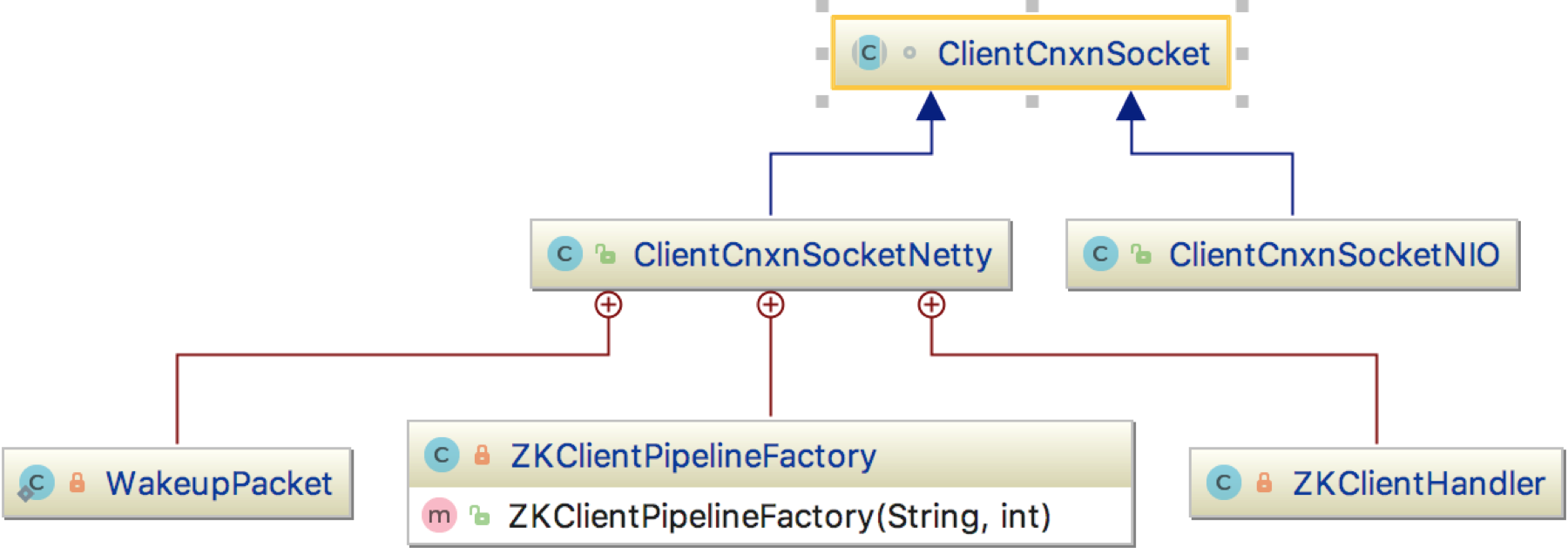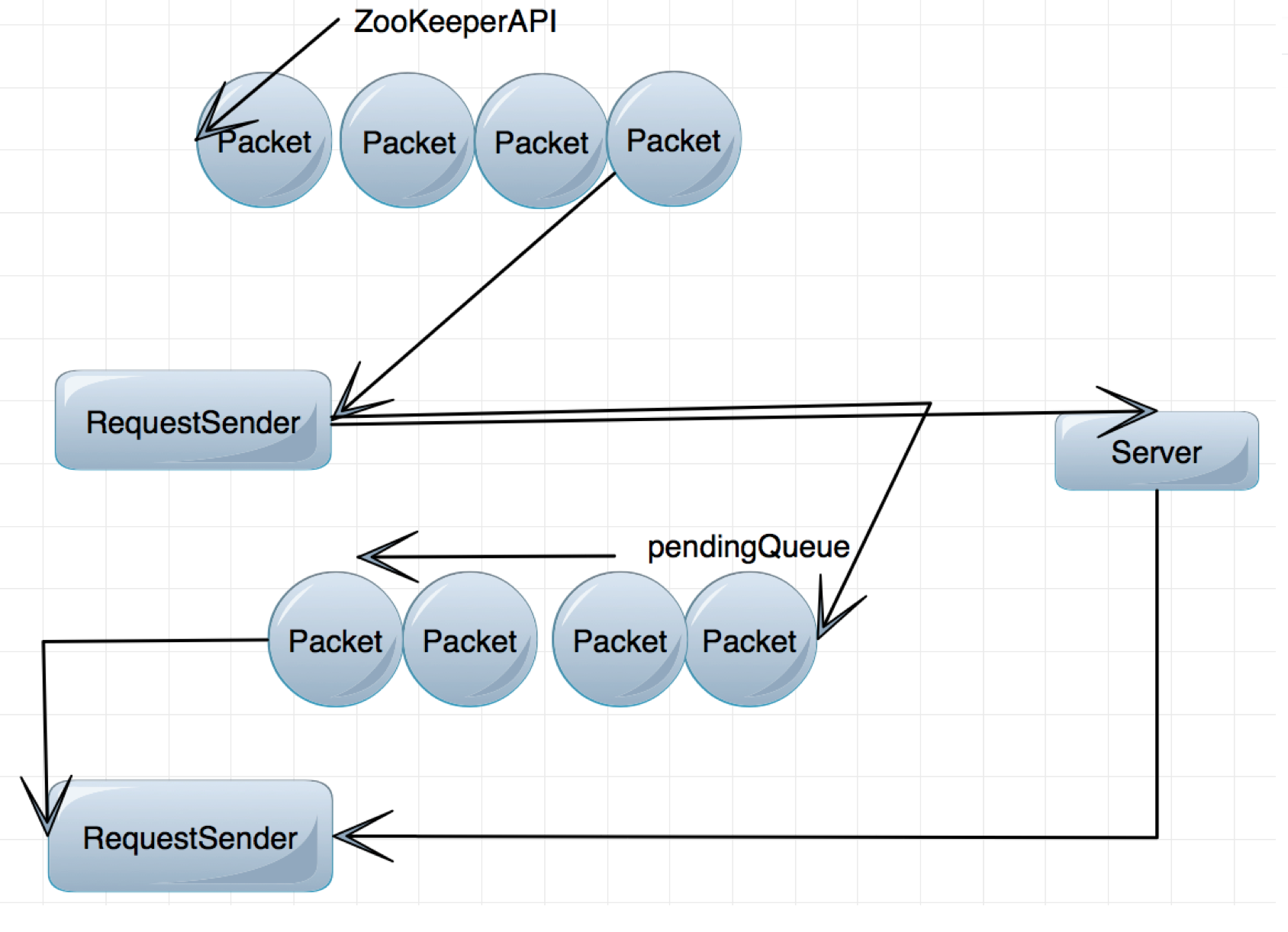您好,登錄后才能下訂單哦!
您好,登錄后才能下訂單哦!
這篇文章將為大家詳細講解有關如何理解zk-client通信層ClientCnxnSocket,文章內容質量較高,因此小編分享給大家做個參考,希望大家閱讀完這篇文章后對相關知識有一定的了解。
ClientCnxnSocket抽象類結構 定義了底層Socket通信接口,默認實現是ClientCnxnSocketNIO
readConnectResult 讀取server的connnect的response
readLength 方法 讀取buffer長度并給incomingBuffer分配對應大小空間
ClientCnxnSocketNIO 實現
findSendablePacket函數 從outgoingQueue中讀取發送的packet
doIO函數 處理讀寫
doTransport函數
如果連接就緒,調用sendThread連接操作
若讀寫就緒,調用doIO函數
ClientCnxnSocket
屬性

ClientCnxnSocketNIO子類
屬性
//nio中的selector
private final Selector selector = Selector.open();
/**
* nio中的selectionKey
*/
private SelectionKey sockKey;
private SocketAddress localSocketAddress;
private SocketAddress remoteSocketAddress;
方法
@Override
void connect(InetSocketAddress addr) throws IOException {
SocketChannel sock = createSock();
try {
registerAndConnect(sock, addr);
} catch (IOException e) {
LOG.error("Unable to open socket to " + addr);
sock.close();
throw e;
}
//已經連接,但是沒有收到resposne
initialized = false;
/*
* Reset incomingBuffer
*/
lenBuffer.clear();
incomingBuffer = lenBuffer;
}
client和server主要交互函數
@Override
void doTransport(
int waitTimeOut,
Queue<Packet> pendingQueue,
ClientCnxn cnxn) throws IOException, InterruptedException {
selector.select(waitTimeOut);
Set<SelectionKey> selected;
synchronized (this) {
selected = selector.selectedKeys();
}
// Everything below and until we get back to the select is
// non blocking, so time is effectively a constant. That is
// Why we just have to do this once, here
updateNow();
for (SelectionKey k : selected) {
SocketChannel sc = ((SocketChannel) k.channel());
if ((k.readyOps() & SelectionKey.OP_CONNECT) != 0) {
if (sc.finishConnect()) {
updateLastSendAndHeard();
updateSocketAddresses();
sendThread.primeConnection();
}
} else if ((k.readyOps() & (SelectionKey.OP_READ | SelectionKey.OP_WRITE)) != 0) {
doIO(pendingQueue, cnxn);
}
}
if (sendThread.getZkState().isConnected()) {
if (findSendablePacket(outgoingQueue, sendThread.tunnelAuthInProgress()) != null) {
enableWrite();
}
}
selected.clear();
}主要分為讀寫兩種
讀:沒有初始化完成初始化
讀取len再改incomingbuffer分配對應空間
讀取對應response
寫: 找到可以發送的packet
如果packet的bytebuffer沒有創建,那就進行屬性添加
bytebuffer寫入socketChannel
把Packet從outgingQueue中取出,放入pendingQueue中
/**
* @throws InterruptedException
* @throws IOException
*/
void doIO(Queue<Packet> pendingQueue, ClientCnxn cnxn) throws InterruptedException, IOException {
SocketChannel sock = (SocketChannel) sockKey.channel();
if (sock == null) {
throw new IOException("Socket is null!");
}
if (sockKey.isReadable()) {
int rc = sock.read(incomingBuffer);
if (rc < 0) {
throw new EndOfStreamException("Unable to read additional data from server sessionid 0x"
+ Long.toHexString(sessionId)
+ ", likely server has closed socket");
}
if (!incomingBuffer.hasRemaining()) {
incomingBuffer.flip();
if (incomingBuffer == lenBuffer) {
recvCount.getAndIncrement();
readLength();
} else if (!initialized) {
readConnectResult();
enableRead();
if (findSendablePacket(outgoingQueue, sendThread.tunnelAuthInProgress()) != null) {
// Since SASL authentication has completed (if client is configured to do so),
// outgoing packets waiting in the outgoingQueue can now be sent.
enableWrite();
}
lenBuffer.clear();
incomingBuffer = lenBuffer;
updateLastHeard();
initialized = true;
} else {
sendThread.readResponse(incomingBuffer);
lenBuffer.clear();
incomingBuffer = lenBuffer;
updateLastHeard();
}
}
}
if (sockKey.isWritable()) {
Packet p = findSendablePacket(outgoingQueue, sendThread.tunnelAuthInProgress());
if (p != null) {
updateLastSend();
// If we already started writing p, p.bb will already exist
if (p.bb == null) {
if ((p.requestHeader != null)
&& (p.requestHeader.getType() != OpCode.ping)
&& (p.requestHeader.getType() != OpCode.auth)) {
p.requestHeader.setXid(cnxn.getXid());
}
p.createBB();
}
sock.write(p.bb);
if (!p.bb.hasRemaining()) {
sentCount.getAndIncrement();
outgoingQueue.removeFirstOccurrence(p);
if (p.requestHeader != null
&& p.requestHeader.getType() != OpCode.ping
&& p.requestHeader.getType() != OpCode.auth) {
synchronized (pendingQueue) {
pendingQueue.add(p);
}
}
}
}
if (outgoingQueue.isEmpty()) {
// No more packets to send: turn off write interest flag.
// Will be turned on later by a later call to enableWrite(),
// from within ZooKeeperSaslClient (if client is configured
// to attempt SASL authentication), or in either doIO() or
// in doTransport() if not.
disableWrite();
} else if (!initialized && p != null && !p.bb.hasRemaining()) {
// On initial connection, write the complete connect request
// packet, but then disable further writes until after
// receiving a successful connection response. If the
// session is expired, then the server sends the expiration
// response and immediately closes its end of the socket. If
// the client is simultaneously writing on its end, then the
// TCP stack may choose to abort with RST, in which case the
// client would never receive the session expired event. See
// http://docs.oracle.com/javase/6/docs/technotes/guides/net/articles/connection_release.html
disableWrite();
} else {
// Just in case
enableWrite();
}
}
}
查詢待發送隊列中可以發送的packet
private Packet findSendablePacket(LinkedBlockingDeque<Packet> outgoingQueue, boolean tunneledAuthInProgres) {
//沒有要發送的,返回null
if (outgoingQueue.isEmpty()) {
return null;
}
// If we've already starting sending the first packet, we better finish
if (outgoingQueue.getFirst().bb != null || !tunneledAuthInProgres) {
//取隊列第一個進行發送
return outgoingQueue.getFirst();
}
// Since client's authentication with server is in progress,
// send only the null-header packet queued by primeConnection().
// This packet must be sent so that the SASL authentication process
// can proceed, but all other packets should wait until
// SASL authentication completes.
//有正在認證處理,發送空請求頭包給服務端
Iterator<Packet> iter = outgoingQueue.iterator();
while (iter.hasNext()) {
Packet p = iter.next();
if (p.requestHeader == null) {
// We've found the priming-packet. Move it to the beginning of the queue.
iter.remove();
outgoingQueue.addFirst(p);
return p;
} else {
// Non-priming packet: defer it until later, leaving it in the queue
// until authentication completes.
LOG.debug("deferring non-priming packet {} until SASL authentation completes.", p);
}
}
return null;
}發送接收packet圖

關于如何理解zk-client通信層ClientCnxnSocket就分享到這里了,希望以上內容可以對大家有一定的幫助,可以學到更多知識。如果覺得文章不錯,可以把它分享出去讓更多的人看到。
免責聲明:本站發布的內容(圖片、視頻和文字)以原創、轉載和分享為主,文章觀點不代表本網站立場,如果涉及侵權請聯系站長郵箱:is@yisu.com進行舉報,并提供相關證據,一經查實,將立刻刪除涉嫌侵權內容。